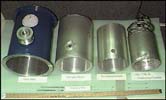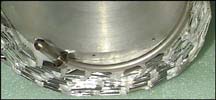In
order to maintain the TopHat detectors at 0.3 K for
a long duration balloon flight, we have had to push
long hold time cryogenic technology to its limits. The
completed TopHat cryostat is shown in Figure 1.
The
circular port on the lower left is for the optical beam,
and is shown with a solid Aluminum blank. The cryogenic
plumbing and electrical connectors are located at the
top. The following table summarizes the current, as-tested,
characteristics of the cryostat. Some areas are still
being improved to increase our operating margins for
a 10-day flight.
| Item |
Volume
(liters)
|
Mass
(kg)
|
Cryogen
Capacity
(kg)
|
Hold
Time
(days)
|
| Vacuum
Jacket |
|
|
-
|
-
|
| Liquid
Nitrogen Tank |
|
|
|
-
|
| Isothermal
Shield |
-
|
|
-
|
-
|
| 4He
Tank |
|
|
|
17
|
| Condensing
Dewar |
|
|
|
-
|
| 3He
Tank |
|
-
|
|
14
|
The
total mass of the dewar together with the cryogen
is 11 kilograms. The entire hold time for the dewar
when it is in full operation is 14 days.
How does it work?
This
cryostat keeps the detectors and optics at 0.25 K (-273
C) for 2 weeks. The cold temperatures are reached by
evaporating liquid 3He (a rare isotope of
Helium) which has the lowest boiling point of any material.
In this case the boiling point is further reduced by
pumping on the 3He to about 4x10-7
of atmospheric pressure with a Zeolite adsorption pump.
This effect is what makes water boil at a lower temperature
at high altitudes (lower pressure). We use about 1 mole
(3 g) of 3He, which allows us to keep the
volumes small and the mass low. This is one of the keys
to this cryostat. By miniaturizing, we can dramatically
reduce mass and therefore the size of the support structures,
thus minimizing parasitic conducted heat and maximizing
hold time. Figure 2 shows the main mechanical parts
of the cryostat.

Figure 3.
It
contains a total of four internal tanks, one vapor cooled
isothermal shield, a vacuum jacket, and small stainless
steel support suspensions. An aluminum can kept at 2.7
K by 4He ("normal" Helium) surrounds the
3He tank. At atmospheric pressure 4He
boils at 4 K but to reduce the heat load on the 3He
stage we reduce the pressure on the 4He to
about 1/3 atmospheric pressure. During flight, no pump
is needed since the external pressure is low enough
to provide this effect. See Figure 3 for a photograph
of the 4He tank.

Figure 4.
Notice
the helical fill/vent tube that provides a long thermal
path in a small space. Surrounding the 4He
tank with an aluminum can reduces its heat load. 4He
gas "boiling" out from the 4He tank cools
this can, also called the isothermal shield. The isothermal
shield is, in turn, surrounded by a can cooled with
liquid nitrogen (77 K). The nitrogen tank has 50 layers
of superinsulation to reduce the radiation from the
warm vacuum shell.

Figure 5.
The
main job of the vacuum shell is to keep air out. Even
a small amount of air leaking into the cryostat would
quickly condense on the cold surfaces and conduct large
quantities of heat into the dewar. What's special about
this 3He cryostat? This cryostat is unique
in its ability to remain cold *unattended* for over
two weeks at balloon altitudes, while being very small
and light.
Why
is it needed?
The
detectors used in TopHat are bolometers. These bolometers
detect incoming radiation by measuring temperature changes
when radiation is absorbed on the detector. Since the
only requirement on the bolometer is that it absorb
the radiation, these detectors are inherently very wide
band devices and very suitable for continuum measurements
in the far-infrared. Similar technology has been used
from 1 cm wavelength microwaves to X-rays. Keeping the
bolometers very cold has two major advantages: 1) It
reduces the thermal noise inherent in all warm materials,
and 2) At low temperatures the heat capacity of the
detectors are greatly reduced, making the temperature
excursions much larger for the same input energy (and
thus making them more sensitive).
Technological
Improvement.
Although
cryostats have been around for a long time this design
has a longer hold time than any of comparable weight,
and a lower weight than any of comparable hold time.
The features that make this possible are: 1. The doubly
reentrant pump tube on the 3He stage that
has lower flow impedance and higher thermal impedance
than can be obtained with a single surface tube. The
inner section of the tube is only 0.003" thick. The
"tank enclosing a tank" approach is used throughout
to reduce the radiation loads and to build a strong
and modular design. Each tank is supported with eight
small stainless steel wires to reduce the thermal conduction
between stages. 2. The fill and vent tubes are arranged
in a double helix to allow them to be long and thin
and still fit within a small volume. For example, the
4He fill/vent tube is 36" long even though
the entire dewar is only 10" in diameter and 17" high.